A Lexicological Study of Arabic and Judaeo-Arabic in Iraqi Hebrew Novels
by Mohamed A. H. Ahmed
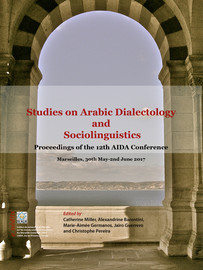
ABSTRACT
Sami Michael (b. Baghdad, 1926), Shimon Ballas (b. Baghdad, 1930) and Eli Amir (b. Baghdad, 1937) are three Iraqi Jewish authors who immigrated to Israel, having left Iraq during the mass migration of Jews from Arab countries during the 1950s. Although their mother tongue is Arabic, these three Iraqi Jewish authors felt that they needed to write in Hebrew if they were to have successful literary careers in Israel. Nonetheless, Arabic still appears in their literary works. Yet, the Arabic variety employed in their literary works belongs, in many aspects, to the so-called Iraqi Judaeo-Arabic.
This study investigates the Judaeo-Arabic lexical items used in six modern Hebrew texts written by the three Iraqi Jewish authors mentioned above. The novels were published between 1964 and 1993. A semantic field analysis is applied to a corpus of six hundred pages, in which the first 100 pages of each novel are taken as a sample. The study shows in numerical statistics the portion of each semantic field used in the corpus followed by a discussion of the data in the view of the linguistic analysis of the phonological, morphological, syntactic and ethnographic aspects of the Iraqi Judaeo-Arabic lexical items in accordance with the texts.
1. Introduction
1.1. Iraqi Judaeo-Arabic Literature
- 1This study uses Geoffrey Khan (2007: 526) terminology of Judaeo-Arabic.
- 2It is important to point out the variety of Hebrew/Arabic uses; not only Jews wrote their Judeo-Ara (…)
1As a result of contact between Hebrew and other languages since the dispersion of the Jews, many linguistic varieties were being developed and used by Jews according to the linguistic and geographical locations in which communities resided. These different languages share the use of Hebrew script as well as the use of loan words from biblical Hebrew and Aramaic on the one hand and adopt the lexical, syntactical and grammatical rules of the adopted languages (i.e. non Hebrew) on the other. By mentioning Judaeo-Arabic, I refer to Arabic texts which were written in Hebrew script.1 Judaeo-Arabic can be defined as a linguistic variety that has been used by Jews in the Middle East and North African countries from the 9th century up to the modern times. The most obvious feature in Judaeo-Arabic texts is orthographical: the use of Hebrew script.2 Another important and common feature of such texts is the employment of Aramaic and Hebrew lexical elements. Although Arabic is the dominant language in Judaeo-Arabic texts, Hebrew is used in two main forms; the first form is that the texts are written mainly in Hebrew typescripts, and second with the use of Hebrew lexicon in terms of implementing single lexical items or phrases in Judaeo-Arabic texts.
2In almost all Judaeo-Arabic texts the dominant language is Arabic, although the Hebrew script was mainly and widely used to write these texts. The linguistic features and the style of Arabic used in these texts were derived primarily from classical or middle Arabic. The significance in Judaeo-Arabic texts also stems from the diversity and the varieties of themes, style, registers, the portion of languages involved and the different genres employed in these texts. This includes fiction, poetry, philosophy, science and religious texts.
3Iraq was one of the famous rabbinic learning centres in the Middle Ages; the assertion that the Jewish people adopted Arabic during this period is demonstrated by the fact that Jews were sharing Arabic with other communities in Babylon (Ben-Shammai: 16). The themes used in Iraqi Judaeo-Arabic texts at the time were mainly associated with religious, e.g. the translation and the interpreting of Bible and other sacred Judaic texts into Judaeo-Arabic, as well as liturgical texts concerning Judaic ceremonies, like the Passover Haggada (Avishur 1979: 84). Indeed, this remains close to the macro level of Judaeo-Arabic.
- 3Saadia Gaon al-Fayyūmi (882-942 C.E) is one of the most famous Jewish thinkers, philosophers and in (…)
4One of the most significant contributions in the history of Iraqi Judaeo-Arabic are the works of Saadia Gaon3 (882-942 C.E) who is famous for the translation of the Pentateuch into Judaeo-Arabic. His writing style, probably based on earlier Bible translations, became highly influential for the development of a literary standard Judaeo-Arabic throughout the Middle East and North Africa due to the popularity of his work. The works of Saadia Gaon were diverse, although lots of them were discovered incomplete, in fragments or have been mentioned in quotations in other works by later writers (Malter 1921: 137). His works also cover many fields of knowledge including, as Malter (1921: 137) counts: “Hebrew philology, Liturgy, Halacha, Calendar and Chronology, Philosophy, and Polemics”.
5As for the literary contributions of Iraqi Jews in modern times, the majority of Jewish writers, for instance, preferred to compose poetry and fiction in Modern standard Arabic (Snir 2005: 79–134). However, Jewish folklore writings flourished and were written in Iraqi Judaeo-Arabic from the mid-nineteenth century. The folklore literature of Judaeo-Arabic written by Iraqi Jews can be divided into three categories: 1) Translations and copies from Jewish sources, 2) Translations and copies from foreign sources, and 3) Local folklores written by Iraqi Jews themselves (Avishur 1979: 84–86).
- 4See, for example, the Hebrew words (עמידה, שבחות, נשמתו) appear in Arabic script respectively:
6Iraqi Judaeo-Arabic has also been employed in the literary works written in Arabic script by Iraqi Jews; the Arabic novels and short stories written in Israel by Samir Naqqāsh (b. Baghdad, 1938-2004), for instance, are full of entire paragraphs written in Judaeo-Arabic. Hebrew words are inserted here and there in the novels in Arabic script, Naqqāsh provides a glossing in the footnotes for such words or/ and sentences.4
7Judaeo-Arabic periodicals that appeared in the nineteenth century in Iraq can be considered among the late literary contributions of Iraqi Jews in Judaeo-Arabic before their mass immigration to Israel during the 1950s. With the emergence of the industry of printing in the nineteenth century, there were more than fifteen printing presses in Iraq between 1850 and 1950 that offered publications on a range of various topics related to Jewish life in Iraq (Al-Ma‘adīdi 2001: 31–37).
1.2. Some Linguistic Features of Iraqi Judaeo-Arabic
- 5For more information about the qeltu-gelet dialects, see Blanc 1964.
8In general, Iraqi Judaeo-Arabic was spoken mainly by Jews at home in Iraq, this vernacular was different, regarding some phonological and lexical aspects, from other Arabic dialects spoken by both Muslims and Christians in Iraq (Blanc 1964). The distinctions between Arabic dialect spoken by Jews and other dialects in Iraq at the time was due to the influence of Classical Arabic on the vernacular spoken by Jews, as well as the use of Hebrew and Aramaic lexical items. It has been noticed that the Iraqi Judaeo-Arabic was spoken only by Jews in Iraq, neither Muslims nor Christians spoke this indigenous vernacular, and because Judaeo-Arabic was a minority vernacular in Iraq, most communication between Muslims and Jews was mainly by means of the Muslim-Arabic vernacular (Moreh and Bramson 1997: 215). Blanc (1964) concluded with an important historical aspect of the three main dialects spoken in Iraq by Jews, Muslims and Christians. Comparing the two main dialects spoken at the Mesopotamian area; qeltu-dialects and gelet dialects,5 he pointed out that Muslims communicated in the newer, more rural variety gelet-dialects, while Jewish-Christian spoke in the older, Metropolitan qeltu–dialects.
- 6For more information and examples about this phenomena, see Blanc 1964.
- 7See, for instance, the study of Judaeo-Arabic in Aqrah and Erbil (Jastrow 1990).
9With reference to consonants, the Judaeo-Arabic spoken in Iraq shared almost the same consonants of both Arabic dialects spoken by Muslims and Christian (Blanc 1964: 17). Yet the way in which such consonants are connected to short vowels was not the same in the three main dialects spoken in Iraq by Muslims, Jews and Christians (Blanc 1964: 31). Blanc claimed that: “In M (Muslim dialect) […] the /e/ has allophones clustering about a higher, more forward position than the /e/ of JC (Jewish and Christian Arabic dialects, M.A) (1964: 31).6 One should add here the different accent and pronunciation of Iraqi Judaeo-Arabic according to the geographical locations, e.g. Baghdadi Jews, Mosul, Aqrah and Erbil.7
10From a phonological comparison between Classical Arabic, the Arabic dialect of Iraqi Jews and the Arabic dialect of both Muslims and Christians, one can sum up with a result that the Arabic dialect spoken by Jews in Iraq was much closer to Classical Arabic than the other two dialects spoken by Muslims and Christians (Mansour 1991: 26–32; Blanc 1964: 20).
- 8For more debate on this issue, see Mansour 1991.
11Iraqi Judaeo-Arabic is famous for the pronunciation of the Arabic consonant /r/, which is pronounced as /ġ/, different from any other Arabic dialect spoken in Iraq.8 Blanc (1964: 23–25) asserts that the use of /r/ and /ġ/ had a long history in the Iraqi Judaeo-Arabic paradigm and was associated with the way Iraqi Jews read the Tanakh (Hebrew Bible). He noted that the /r/ sound, according to Saadia Gaon, had two ways of pronunciation (together with the b, g, d, k, p, and t), one is soft, and the other is hard.
12Another comparison between some Arabic consonants that were spoken by Jews in Baghdad is the pronunciation of /q/ and /k/. The pronunciation of the Jews regarding these consonants is quite close to Classical Arabic. On the other hand, they are not pronounced in the same way among Muslims and Christians (Blanc 1964: 26).
13In the realm of syntax, the Iraqi Judaeo-Arabic shares linguistic elements concerning syntactic structure from Mishnaic Hebrew. The linguistic elements which are incorporated in Iraqi Judaeo-Arabic not only derived from Aramaic and Hebrew languages, but also from Persian and Turkish. It has been thought that this linguistic influence may have contributed to the lexical and syntactic constructions of Iraqi Judaeo-Arabic (Mansour 1991: 25–50).
- 9See, for instance, the use of mazzal [luck] and sakkana [danger], among others, in Judaeo-Arabic sp (…)
14In respect to lexicography, the use of some Hebrew lexical items in the Iraqi Judaeo-Arabic is not determined exclusively by religious discourse; rather there are also secular uses of Hebrew elements.9
1.3. Semantic Field Analysis
15According to the semantic field theory, the lexical sets can be arranged in groups of words of which their meanings are closely interconnected. Semantic field theory can be defined as “an approach which developed in the 1930s: it took the view that the vocabulary of a language is not simply a listing of independent items (as the headwords in a dictionary would suggest), but is organized into areas, or fields, within which words interrelate and define each other in various ways” (Crystal 2008: 429).
- 10For more information about the semantic field theory see Kleparski & Rusinek 2007; Jackson & Zé Amv (…)
16German and European linguists have mainly developed the semantic field theory from the 1930s onwards. Preliminary work on semantic field theory was undertaken by Porzig, Ipsen and Trier. Trier’s ideas are the most important concept in the semantic field theory (Nerlich 1992). He introduced the notion of semantic filed in the 1930s, in which “meaning was defined by the relations between words, not by reference to things, representations or any other external yardstick” (Nerlich 1992: 117–118).10
17Semantic field theory is based on three main perspectives: the diachronic, the synchronic and the lexicography. In addition, “other areas of semantics include the diachronic study of word meanings (etymology), the synchronic analysis of word usage (lexicology), and the compilation of the dictionaries (lexicography)” (Crystal 2008: 429). The study at hand is concerned with the synchronic analysis of the Iraqi Judaeo-Arabic lexical items used in the corpus. Although a sociolinguistic study of the Arabic use in the Iraqi Jewish fiction is opportune, this study tends to introduce a lexicological investigation of the use of Arabic in modern Hebrew texts.
2. The Data
18The data is derived from six Hebrew novels written by three Iraqi Jewish authors: Ballas (1964; 1991), Michael (1974; 1993) and Amir (1983; 1992). Every instance of Arabic is counted in the analysis. Proper names are excluded from the linguistic analysis of the study, although they have a great deal in the novels. However, they are discussed with examples in the paper due to their importance. For the precise purpose, the data is gathered from the first 100 pages of the six novels, 600 pages are the total page numbers in the analysis.
19Arabic instances are written in Hebrew script in all novels by Iraqi Jewish authors. The paper at hand inspects all Arabic terms in the texts, including both standard Arabic and Iraqi Judaeo-Arabic. The study at hand also consulted some Iraqi Judaeo-Arabic dictionaries concerning the analysis of the extracted Arabic examples from the novels, such as Yona-Swery 1995, Yosef 2005 and Ben-Jacob 1998.
- 11For more information see the appendices of this paper, which contain all Arabic extracts from the s (…)
20The Judaeo-Arabic instances are categorised into lexical sets according to the semantic field analysis of the data. All Arabic extracts found in the corpus were linguistically investigated by the contextual settings in which the embedded Arabic terms occur. In addition, the study indicates whether the Arabic uses in the corpus occurs in the narrative or the dialogue mode.11 Table 1 demonstrates the Arabic and Iraqi Judaeo-Arabic instances found in the Hebrew novels according to the semantic fields and other lexical categories.
Table 1. Arabic and Judaeo-Arabic according to semantic fields and other lexical categories
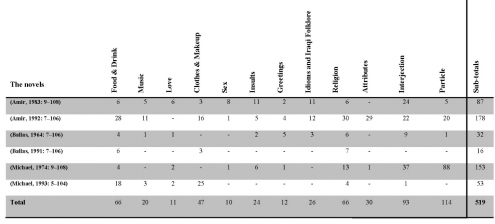
3. Arabic use in the corpus
3.1. Lexical sets
21According to the table, particles are the dominant lexical set in the corpus with about 22% followed by interjections of approximately 18%, and religion with 12,7 %. The food & drink in the corpus has the same portion of religion with 12,7 % of the total lexical sets extracted from the Hebrew novels.
22The use of Arabic particle, as pointed out above in the table, is the dominant lexical set used. The main particle used is /yā/. Interesting is that this particle the particle, mainly the use of /yā/, is the most used item in Michael’s novels (1974; 1993). Indeed, /yā/ particle is employed in various ways in the corpus. The main purpose of inserting such particle is calling somebody by using /yā/ as a prefix before the name. e.g.: yā Abū Fuʾād “hey Abū- Fuʾād” (Ballas 1964: 8). Besides, /yā/ has other uses that call attention to the Arabic Iraqi vernacular. For instance, the use of /yā/ in combination with Allā is associated with expressing the feelings of anger and sorrow; Abū-Shaul, the father of David, the protagonist in the novel Shavīm ṿe-shavim yuter (“More and More Equal”), expresses his annoyance and anger with the bitter life in the Maʿabara, he says:
(1)
יא-אללה, אשה – – לכל הפחות לטבול לחם במשהו
yā-Alla išā – likol ha-paḥot litvol leḥem bi-mišihū
“Oh God, woman – at least to dip some bread in anything”
(Michael 1974: 13)
23Another use of /yā/ is to be added to Hebrew lexical items/adjectives giving different denotations, e.g. to express humour, like in the dialogue between David and his colleague from Yemen during their military service in the 1967 war. The ‘Yemenite’ offers David a cigarette:
(2)
קח יא ממזר
qaḥ yā-memazer
“take it bastard”
(Michael 1974: 14)
24The particle /yā/ is also used in referring to non-human objects:
(3)
לא כל כך מהר, יא-רכבת
lo kol kaḫ mahēr yā-rakkevet
“hey train, do not go so speedy”
(Michael 1974: 23)
25Shaul, one of the main protagonists in Michael novel, said the above sentence while he was trying to catch and spring outside the moving train in which all his family was riding. The use of Arabic particle, mainly /yā/, which is associated with the act of calling someone, is a unique feature in the Hebrew texts. Indeed, the use of this particle reflects the Iraqi vernacular used by some characters in the novels. Some novels used Arabic particle extensively in almost every dialogue between the characters when it involves calling someone by his name.
26Interjections come in the second place after particles. They are used mainly in the dialogue mode and connected mostly to colloquial idioms, e.g. יא עיני yā ʿīnī “hey my eye – cool” (Amir 1983: 174); וואללה wallah “I swear to God” (Michael 1974: 14); יאבוי yābūy “hey my father – Oh God” (Ballas 1964: 29);מאשללה māšallah “God bless” (1992: 23); תַבַּארַכּ אללה tabārak Allah “God bless” (1992: 52, 53); יאללה yallah “Lets go” (1983: 18); וַאֵוילִיwāwēli “what a catastrophe!” (1992: 13, 22). The use of such lexical items serves likewise as a stylistic device reflecting the use of many Iraqi characters employed in the novels of the corpus. Also, such uses of vernacular items, interjection and particle, imbue the conversations in the three early Hebrew novels with the local colour of Iraq/Baghdad.
- 12An Iraqi dish, it is a soup made from certain parts of the sheep’s meat, like stomach, tongues, che (…)
- 13This is also an Iraqi Jewish favorable dish, see Yosef (2005).
- 14An art of playing Arabic music using only one instrument. According to the dictionary of Iraqi Juda (…)
- 15Karaḫāne is a Turkish term used during the Ottoman Empire to refer to a brothel. Many Arabs borrowe (…)
- 16Ṭawla is a famous Arabian play, this is also a play that Iraqi Jews love to play, see Yosef (2005); (…)
27According to semantic analysis in the data collected from the six Hebrew novels, the use of Arabic lexical sets varied. This includes, for instance, foods: פאצ’ה pāžeh12 (Ballas 1964: 28, 77), בַמְיהbamyeh (Michael, 1993: 14)13, קובהkubba “crushed meat” (Michael 1974: 71, 72) and also in (Michael 1993: 48); music: חפלה ḥafla “party” (Amir 1983: 106), תקאסים taqāsīm14(Amir 1983: 107); sex: טיז ṭīḍ “Buttocks” (Amir 1983: 24, 25, 51), כרכאנה karaḫāne15(Amir 1983: 58), שארמוטה šarmūṭa “bitch” (Michael 1974: 24); and clothes: תרבוש tarbūš “a red hut” (Amir 1983: 39), דִשְדַאשַה dišdāša “an ankle-length Arab garment” (Amir 1992: 94; Ballas 1991: 103); and Arabic games, like טאולהṭāwla16 “backgammon, a board game” (Ballas 1964: 11).
28The table shows that the differences between the total portions of lexical sets of the corpus are to some extent narrow. Keeping this fact in mind, the use of Arabic andIraqi Judaeo-Arabic can be arguably seen as variable and not limited to certain lexical sets.
3.2. Orthographic Observations
29Spoken Judaeo-Arabic by Iraqi Jews is well represented in the corpus; this is shown in the ethnographic style of writing some Judaeo-Arabic lexical items using Hebrew graphemes, such as this example:
(4)
כל טיז יסוה אל עמע
kol ṭīḍ yeswa al-ʿumeġ
“Each Buttock is worth a life — what a beautiful ass”
(Amir 1983: 19)
30This example shows a significant feature in the Iraqi Judaeo-Arabic consonants. which is the use of Arabic constant /ġ/ instead of /r/, a feature that distinguishes the Judaeo-Arabic variety and gives distinction to it. Only Jews in Iraq adopted this feature as it is discussed by Blanc (1964: 20). Here Eli Amir writes the word ʿumeġ with (ע’) /ġ/ to highlight this orthographic feature.
31The use of התַנוּעַה ha-tanūaʿa, which refers to the Zionist movement, replaces the Hebrew equal idiom התְנוּעׇה הציונית ha-tenuʿa ha-tsyonīt. The comparison below between the origin and the hybrid phonological structure is to illustrate phonological Arabic/Hebrew interference:
(5)
a – התְנוּעׇה הציונית ha-tenuʿa ha-tsyonīt
b – תַנוּעַה tanūaʿa
32The comparison between (a) and (b) shows that the way the Hebrew lexical item ha-tenuʿa differs from the spoken term by the Jews at the time; in (b) the short vowel /a/ comes instead of /e/ in (a). The Hebrew definite article /ha/ is not used in (b) either.
33The use of Arabic language here shows that the existence of Arabic is not only assembled in adding Arabic codes to the Hebrew texts; rather it proves that the Arabic influence affects both the phonological and semantic levels. The term tanūaʿa is not just an alternation of the Hebrew phonological structure of the origin lexical tenūaʿa; rather it was used in Iraq shortly before 1948 to refer semantically to ha-tenu‛a ha-tsyonīt “the Zionist movement”.
34Another observation from the data collected from the Hebrew novels is associated with the method of writing the Arabic letters in Hebrew script. The examples below show the way in which each author has a different style concerning the orthography of some Hebrew graphemes:
(6)
a -וִחְיַאתַכְּwe-ḥyātak “please, I beg you” (Amir 1992: 65)
b – דח’ילך daḫīlak “please, I beg you” (Ballas 1964: 63)
- 17See for instance: (Wagner 2010: 27; Blau 1980: 47).
35The consonant /k/ is written in two forms, the first in (6-a) is written in the regular form of Hebrew /k/, whereas in (6-b) the author uses the final Hebrew form of /k/. Besides, in (6-a) the /k/ comes with a dot (dagēš qal) to be distinguished from the consonant /ḫ/. On the other hand, in (6-b) the /k/ comes without the dot. This observation reflects a long history of such orthographic features in the Judaeo-Arabic paradigm back to the 13th century.17 The same holds true for the next two cases of writing the Arabic consonant /ḫ/ in Hebrew script. In (7-b) it is written with stroke above the Hebrew consonant /ḥ/, while in (7-a) the Hebrew consonant is written without stroke:
(7)
a -חאזוקḫazūq “impalement” (Michael 1974: 78)
b -מוּחְ’תַארmuḫtār “a Chairman of the neighbourhood” (Amir 1992: 80)
3.3. Morphological and syntactic observations
36The corpus shows an interesting phenomenon regarding some syntactic and morphological aspects. This is obvious, for instance, in the use of Hebrew inseparable prepositions (ל, ב, כ) as well as the Hebrew definite article ((ה, e.g. הג’רה ha-Jarre “the water jug” (Amir 1992: 7) with Arabic lexical items instead of using Arabic definite article /ال/ like Ballas does in אל-מוח’אבראת al-muḫābarāt “the Intelligence” (Ballas 1991: 37); בפינג’אנים be-fenjānīm “in cups of coffee/tee” (Amir 1992: 27); בעַמְבַּה be-ʿamba “Amba, an Iraqi traditional dish” (Amir 1992: 35); לחַפְלות הליליות la-ḥaflot ha-lelyilyot “to the night parties” (Amir 1992: 36). The repeated use of ʿabāye in Michael’s sample shows an interesting aspect which is associated with Arabic and Hebrew morphological interference and demonstrates how Arabic lexical items are integrated into the Hebrew texts. Besides, Michael incorporated ʿabāye into the Hebrew text using the rules of the Hebrew adjunct. For instance, עבית משי ʿabayet mēšī “Abaya made of silk” (1993: 30).
37Amir has a distinct style of employing some Arabic nouns in the sample. He often uses the Hebrew female plural suffix for Arabic lexical items:
(8)
גברים בעביות כהות ובכפיות מנוקדות
gevārīm be-ʿabāyot kehot ʾu-bekofiyot menuqadot
“Men in dark cloaks and dotted Keffiyehs”
(Amir 1992: 17)
38In this example, the two Arabic lexical items ʿabaye and kefiyye are loaned into Hebrew using the Hebrew suffix /ot/ associated with Hebrew female plural terms. The other Hebrew form of plural used for the masculine plural, the suffix /īm/, is also employed by Amir to make the plural of Arabic lexical item וזיר wazīr “minister” and שֵיח’šēḫ “sheikh”, they appear in Amir’s text as: ושֵיח’ים וַזירים (1992: 36). Arabic, in view of this, is more integrated into Hebrew texts. This was not done only by means of inserting Arabic lexical items, but also in applying Hebrew morphology to them.
39Iraqi Judaeo-Arabic is also pointed out in Michael’s novel. The next example demonstrates the use of Hebrew lexical items in Arabic spoken by Jews in Iraq. The author here inserts the Judaeo-Arabic paragraph in the Hebrew text followed by his translation into Hebrew:
(9)
The text as appears in the Hebrew novel:
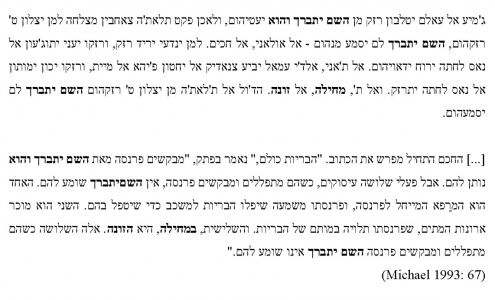
The Arabic transcription
- 18The transcription follows the Hebrew equivalent in Arabic Alphabet.
“جميع العالم يطلبون رزقהשם יתברך והואيعطيهوم18، ولكن فقط ثلاثه صاحبين مصلحه لمن يصلونט’رزقهوم،השם יתברךلم يسمع منهم ــالأولاني، الحكيم.لمن يندعي يريد رزق، ورزقو يعني يتوجعون الناس لحته يروح يداويهوم.الثاني، الذي عمال يبيع صناديق اليحطون فيها الميت، ورزقو يكون يموتون الناس لحته يرتزق.وال ث’،מחילה،الـזונה.هذول الثلاثه من يصلونט’رزقهمהשם יתברךلم يسمعهوم.”
The English translation
“The Ḥaḫām began to explain what is written: “All people”, he said in commenting on the text, “ask for livelihood from the Blessed Lord, and he gives them. However, there are three professions when their practitioners worship and ask for livelihood, but the Blessed Lord does not listen to them. The first is the physician who hopes for livelihood, and his livelihood means that people get ill and he treats them. The second is the seller of coffins, whose livelihood is reliant upon the death of people. And the third, forgiveness, is the prostitute. Those three, when they worship and ask for livelihood, the Blessed Lord does not listen to them.”
40In Michael’s novel Viktoryah, three girls found a piece of paper blowing in the air when they were on the roof of the house. Because they were illiterate, they asked for help to know what was written on the paper. They went to Ḥaḫam, who examined the paper and read it to them. The paper was written in Iraqi Judaeo-Arabic followed by a translation into Hebrew on the same page. The influence of the biblical Hebrew on the Arabic text is obvious, as Blanc noted in his study about the dialects in Baghdad (1964: 140–141); for instance: יתברך השם hashēm yitbarrēḫ “The Blessed Lord”, מחילה meḥīla “forgiveness” and אל זונה al-zona “prostitute”. Note here the use of Hebrew word meḥīla without the Hebrew preposition /ב/. In addition, note the use of the word zona with the Arabic definite article /al/. The Hebrew/Arabic morphological and syntactic interference are obvious in this example.
3.4. Contextual settings
41Contextual settings analysis, in which the context of the plot associated with uses of Arabic, can also provide a general picture of the contextual moods by means of testing the frequencies of each category. In the sample, as illustrated in Figure 1, the use of Arabic terms in the corpus is associated mainly with the highly charged emotions mode, such as exciting 21%, happy 25% or angry 18%. On the other hand, the use of Arabic is associated only with normal context by 30%, especially in connection with the narrative or the non-dialogue technique.
Figure 1. Arabic Contextual settings
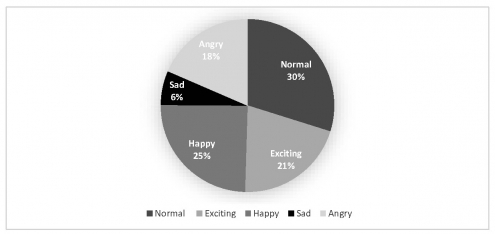
42According to Figure 2, it is clear that Arabic use is repeatedly related to highly charged emotions, like exciting, sets that include for example fear and surprise. Happy, exciting and anger modes constitute a high rank as a semantic set in the Amir sample in both of his early novels (1983; 1992). The set angry, for instance, is associated principally with the use of Iraqi vernacular insults, e.g. כוס אם אל יהוד kos um el-yahūd (1992: 11) “get the hell up!”; אחרא דין בוק iḥra dīn būk “wish your father’s religion is to be burnt – fuck you” (1983: 14). This observation points out the mutual relation between the contextual settings and the expected strategy used by the bilingual author. Moreover, the use of Arabic in the angry mode is mainly done by inserting Arabic terms in the Hebrew text without translation or glossing. Sad ranks lowest as a context in which Arabic is used in the sample. The so-called normal set, which is associated mainly with the narrative mode, is used extensively in the sample from Amir’s novels.
Figure 2. Contextual Settings of Arabic Use according to each author
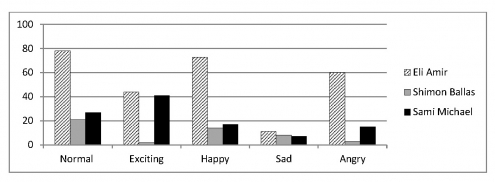
43It is also clear from Figure 2 that Arabic use in Ballas’ sample is associated largely with the normal mode, in which the author uses mainly the narrative or the non-dialogue technique. The use of Arabic is also linked to emotional contexts, e.g. in connection with happiness and sadness. By contrast, Arabic use is quite sparse in relation to contexts of anger and excitement.
44The contextual settings analysis of the sample gathered from the two novels written by Michael shows, too, that the use of Arabic is to some extent related to and associated with highly charged emotions, categories like exciting, angry, sad and happy. The analysis also indicates that in the Hebrew novels, the contextual settings in the first Hebrew novel (1974) are greater than in the second novel (1993) in all categories. There is also a place in Michael’s style allocated for sadness, although it constitutes the lowest frequency in contextual modes in which Arabic is used in Michael’s sample.
3.5. Loan words
45In addition to the fact that the Arabic lexical items used in the Hebrew novels reveal the variety and multiplicity of borrowing from the Arabic lexicon in the Hebrew texts, exemplifying internal borrowing and occurring at the micro level, there are some cases of external borrowing that were employed by the authors in their early Hebrew manuscripts. These cases of external borrowing show the diachronic process of inserting some lexical items into the Hebrew lexicon, mainly slang, which are borrowed from Arabic, such as when a lexical item like מסטול masṭūl “drunk” was used in Ballas’ first Hebrew novel (Ballas 1964: 181). The author added a Hebrew glossing of the Arabic term masṭūl in the footnote. Yet currently, the Hebrew lexicon includes this word (Sagiv 2008: 764), which occurs mainly in Israeli spoken language. This attitude towards such a word from Arabic would not exist if the lexical item masṭūl had already been a borrowed lexical item in Hebrew of the 1960s. In other words, if the Hebrew speakers in Israel at the time the novel Ha-maʿabara (Ballas 1964) appeared had been familiar with this lexeme, Ballas would not have had to add a footnote glossing the term.
46This example given here is neither to claim that the novel of Ballas was the first medium that introduced the loaned term masṭūl to the modern spoken Hebrew lexicon, nor to assert that this lexical item belongs only to Iraqi Jews. However, it is important to reflect on such issues from a diachronic perspective.
4. Conclusion
47To conclude, a corpus of 600 Hebrew pages taken from six Hebrew novels written between 1964 and 1993 were analysed linguistically regarding the Arabic terms inserted in the texts by three Iraqi Jewish authors. The Arabic and Judaeo-Arabic instances were extracted and arranged according to semantic field and other lexical sets. The study showed that the use of Arabic in the given corpus varies. The lexical items sets were analyzed from orthographic, morphological and syntactic perspectives.
48It is evident from the corpus that Arabic is employed in the Hebrew texts in several ways. This finding is based on the wide range of Arabic lexical items found in the texts, as well as the variety of strategies employed by the authors. Arabic is used in the texts in both dialogue and narrative modes, in different contextual settings.
49The use of such lexical items serves likewise as a stylistic device reflecting the use of many Iraqi characters employed in the novels of the corpus. In addition, such uses of vernacular items, interjection and particle, imbue the conversations in the Hebrew novels with the local colour of Iraq/ Baghdad.
BIBLIOGRAPHY
Al-Ma‘adīdi, I. 2001. Al-Ṣiḥāfah al-Yahūdīyyah fī al-ʿIrāq. Cairo: a-ddār al-Dawlīyah lil-Istiṯmārāt al-ṯaqāfīyah.
Amir, E. 1983. Tarnegōl kapparōt (Scapegoat). Tel Aviv: Sifriyat ofaqim.
Amir, E. 1992. Mafriaḥ ha-yōnîm (Farewell, Baghdad). Tel Aviv: Sifriyah la-ʻam.
Appel, R., & Muysken, P. 2005. Language contact and bilingualism. Amsterdam: Amsterdam University Press.
Avishur, Y. 1979. “Ha-sifrut ha-ʿmamit shel-yehude bavel be-ʿaravit Yehudit”, Peʿamim. 3, 83–90.
Ballas, S. 1964. Ha-maʻabara (the transit camp). Tel Aviv: ʿAm ʿoved.
Ballas, S. 1991. Ṿe-hu aḥēr (the other one). Tel Aviv: Zmora-Bitan.
Ben-Jacob, A. 1998. Ōṣār ha-mešālīm weha-pitgāmīm šel yehude Bābel ba-dōrōt ha-aḥarōnīm (Treasury of proverbs of Iraqi Jews in the last era). Jerusalem: Yerid ha-sefarim.
Ben-Shammai, H. 1997. “Jewish Thought in Iraq in the 10th Century”, in: Golb N. (ed.) Judaeo-Arabic studies: Proceedings of the Founding Conference of the Society for Judaeo-Arabic Studies, 15–32. Amsterdam: Harwood Academic Publishers.
Blanc, H. 1964. Communal Dialects in Baghdad. Cambridge: Harvard University Press.
Blau, J. 1971. “ben ʻaravīt yehudīt le-Quran”. Tabriz. 4, 512-514.
Blau, J. 1980. Diqduq ̣ha-ʿArbīt-ha-Yehudīt šel yeme-ha-bēnayim. Jerusalem: Magnes Press.
Blau, J. 1981. The Emergence and Linguistic Background of Judaeo-Arabic: A Study of the Origins of Middle Arabic. Jerusalem: Humanities Press.
Blau, J. 2001. “The Linguistic Character of Saadia Gaon’s Translation of the Pentateuch”, Oriens. 36, 1.
Brody, R. 2013. Sa’adyah Gaon. Oxford: Oxford University Press.
Bullock, B. E., & Toribio, A. J. 2009. The Cambridge handbook of linguistic code-switching. Cambridge: Cambridge University Press.
Crystal, D. 2008. A dictionary of linguistics and phonetics. Malden: Wiley-Blackwell.
Hary, B. H. 2009. Translating Religion: Linguistic Analysis of Judeo-Arabic Sacred Texts from Egypt. Leiden: Brill.
Jackson, H., & Zé Amvela, E. 2000. Words, meaning, and vocabulary: An introduction to modern English lexicology. London: Continuum.
Jastrow, O. 1990. Der arabische Dialekt der Juden von ʿAqra und Arbīl. Wiesbaden: Otto Harrassowitz.
Khan, G. 2007. “Judaeo-Arabic”, Versteegh K. et al. (eds.), Encyclopedia of Arabic Language and Linguistics. 2. Leiden: Brill. pp. 526–536.
Khan, G. 2013. “Transcriptions into Arabic script: medieval Karaite sources”, Khan G. et als. (eds.), Encyclopedia of Hebrew Language and Linguistics. 3. Leiden–Boston: Brill. 792-799.
Kleparski, G. A., & Rusinek, A. 2007. “The tradition of field theory and the study of lexical semantic change”, Zeszyt. 47, 188–205.
Kraus, P. 2009. “Hebräische und syrische Zitate in ismā῾īlitischen Schriften”, Der Islam: 19(4), pp. 243-263.
Malter, H. 1921. Saadia Gaon: His Life and Works. Philadelphia: The Jewish Publication Society of America.
Mansour, J. 1991. The Jewish Baghdadi Dialect: Studies and Texts in the Judeo-Arabic Dialect of Baghdad. Or-Yehuda: The Babylonian Jewry Heritage Center, the Institute for Research on Iraqi Jewry.
Michael, S. 1974. Šāṿīm ve-šāṿīm yotēr. Tel Aviv: Bustan.
Michael, S. 1993. Victoria. Tel Aviv: ʻAm ʻoved.
Moreh, S., & Bramson, O. 1997. Hā-ilān we-he-ʻānāf: has-siprūt hā-ʻivrīt ha-ḥadāšā w-iṣirātām has-sifrūtīt hā-ʻarāvīt šel yoṣeʾē ʻīrāq. Jerusalem: Magnes.
Myers-Scotton, C. 1993. Social motivations for codeswitching: Evidence from Africa. Oxford: Clarendon Press.
Naqqāsh, S. 1980. Yawm ḥabilat wa-ağhaḍat al-dunyā: qiṣaṣ ʿirāqīya. Jerusalem: Matbaʿat al-šarq al-ʿarabiyah.
Nerlich, B. 1992. Semantic theories in Europe, 1830-1930: From etymology to contextuality. Amsterdam: John Benjamins Publishing Company.
Poplack, S. 1980. “Sometimes I’ll start a sentence in Spanish Y TERMINO EN ESPAÑOL”, Linguistics. 18: 7/8. 581–618.
Reif, S. 2000. A Jewish Archive from Old Cairo. The History of Cambridge University’s Genizah Collection. Richmond, Surrey: Curzon.
Sagiv, D. 2008. Qāmūs Sagīv. Jerusalem: Shoken.
Simon, R. S., Laskier M. M., & Reguer, S. 2003. The Jews of the Middle East and North Africa in Modern Times. New York: Columbia Univ. Press.
Snir, R. 2005. ʻArviyūt, yahadūt, ṣiyonut: Maʾavaq zehūyōt be-yeṣīratām šel yehūde ʿīrāq. Jerusalem: Yad Yitshak Ben-Tsevi.
Thomason, S. G. 2001. Language contact. Edinburgh: Edinburgh University Press.
Vollandt, R. 2015. Arabic Versions of the Pentateuch: A Comparative Study of Jewish, Christian, and Muslim Sources. Leiden: Brill.
Wagner, E.-M. 2010. Linguistic variety of Judaeo-Arabic in letters from the Cairo Genizah. Leiden: Brill.
Yona-Swery, G. 1995. Milōn imrōt o-mešālīm šel lahag yehūde Bābel. Jerusalem: agudat ha-akademaʾim yotṣʼē ʻīrāq be-yisraʾel.
Yosef, D. 2005. Sefat ha-ēm: Milōn ha-nōsṭalgeyāh šel ha-ʻīrāqim be-lahag ha-sāfah ha-ʻiraqīt ha-yehūdit. Tel Aviv: Y. David.
ANNEXES
The appendices contain all Arabic and Judaeo-Arabic examples that are extracted from six Hebrew novels. The Arabic extracts are arranged alphabetically in six tables, in which each table contains the collected Arabic terms from each novel. The tables indicate the reference page of each example, the semantic category, the contextual settings and the dialogue/narration mode in which the insertion of each Arabic term occurs.
Abbreviations used in the tables:
N = Narration; D = Dialogue; NO = Normal; EX = Exciting; HA = Happy; SA= Sad; AN = Angry; FU = Funny
Table 2 (Amir 1983: 9–108)
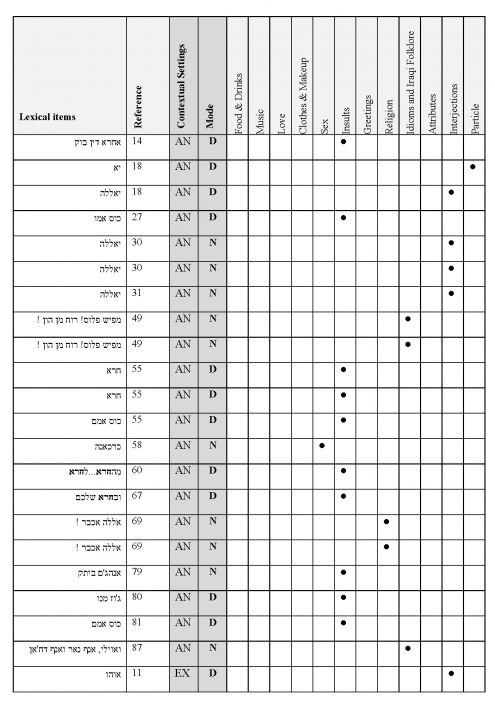
Table 2 (Amir 1983: 9–108)
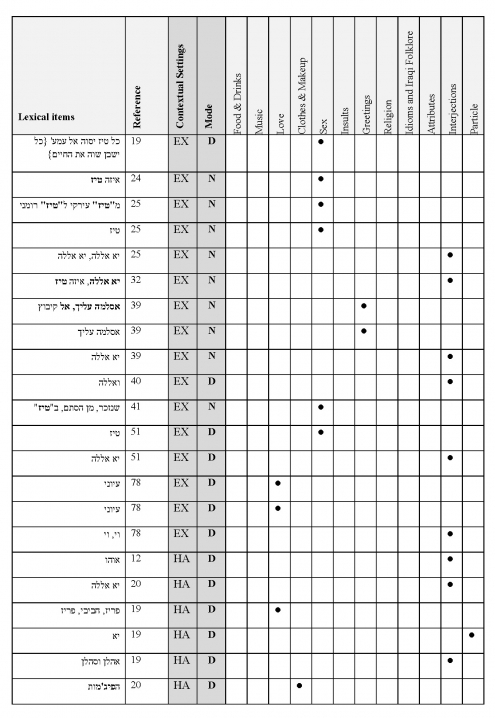
Table 2 (Amir 1983: 9–108)
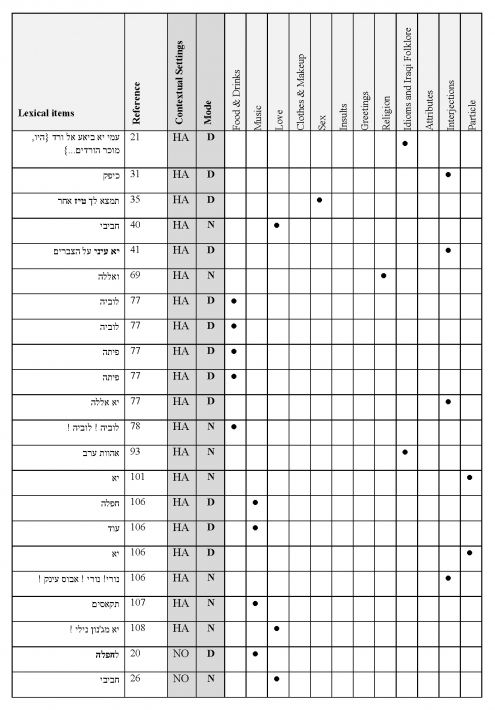
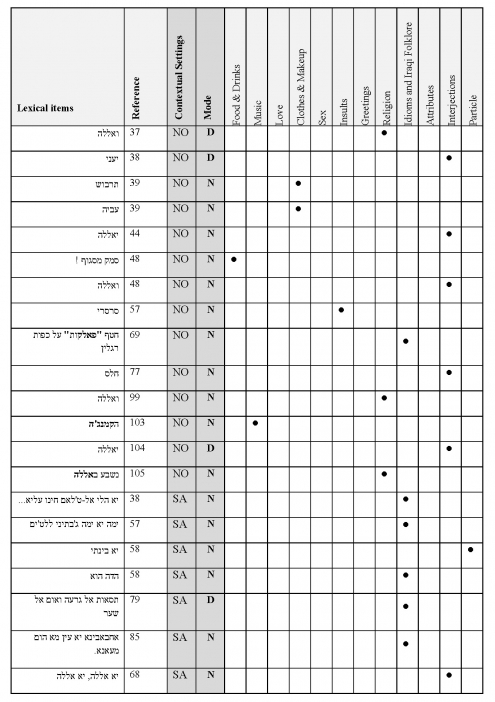
Table 2 (Amir 1983: 9–108) Table 2 (Amir 1983: 9–108) Original (jpeg, 508k)
Table 3. (Amir 1992: 7–106) Original (jpeg, 536k)
Table 3. (Amir 1992: 7–106) Original (jpeg, 528k)
Table 3. (Amir 1992: 7–106) Original (jpeg, 500k)
Table 3. (Amir 1992: 7–106) Original (jpeg, 500k)
Table 3. (Amir 1992: 7–106) Original (jpeg, 532k)
Table 3. (Amir 1992: 7–106) Original (jpeg, 516k)
Table 3. (Amir 1992: 7–106) Original (jpeg, 512k)
Table 3. (Amir 1992: 7–106) Original (jpeg, 516k)
Table 4. (Ballas 1964: 7–106) Original (jpeg, 292k)
Table 4. (Ballas 1964: 7–106) Original (jpeg, 408k)
Table 5. (Ballas 1991: 7–106) Original (jpeg, 492k)
Table 6. (Michael 1974: 9–108) Original (jpeg, 416k)
Table 6. (Michael 1974: 9–108) Original (jpeg, 516k)
Table 6. (Michael 1974: 9–108) Original (jpeg, 496k)
Table 6. (Michael 1974: 9–108) Original (jpeg, 520k)
Table 7. (Michael 1993: 5-104) Original (jpeg, 520k)
Table 7. (Michael 1993: 5-104) Original (jpeg, 209k)
NOTES
1 This study uses Geoffrey Khan (2007: 526) terminology of Judaeo-Arabic.
2 It is important to point out the variety of Hebrew/Arabic uses; not only Jews wrote their Judeo-Arabic manuscripts using Hebrew characters. Rather, there is an evidence that the Judeo-Arabic texts were also written in Arabic script (Blau 1981: 40-43). This phenomenon, although rare in Judeo-Arabic literature (Blau 1981: 41), touches on the variety of forms Arabic/Hebrew can engender. It is interesting to know that the varieties of using Hebrew script have been extended covering even Arabic sacred texts, e.g. the Quran was also written in Hebrew script in the Middle Ages (Blau 1971: 512; Vollandt 2015). Contrariwise, the Hebrew version of the Bible was written in Arabic script as well (Khan 2013; Reif 2000: 106-109). In addition, there were some Islamic texts embedded with Hebrew and Aramaic lexical items (Kraus 1930).
3 Saadia Gaon al-Fayyūmi (882-942 C.E) is one of the most famous Jewish thinkers, philosophers and intellectuals during the Middle Ages in Iraq. He was born in the village of Dilaz in Faiyum which is located in Upper Egypt. For more information about Saadia Gaon, see Malter 1921, Blau 2001, Brody 2013 and Vollandt 2015.
4 See, for example, the Hebrew words (עמידה, שבחות, נשמתו) appear in Arabic script respectively:
( العميدة، الشباحوث ، نشمتو) in Naqqāsh (1980).
5 For more information about the qeltu-gelet dialects, see Blanc 1964.
6 For more information and examples about this phenomena, see Blanc 1964.
7 See, for instance, the study of Judaeo-Arabic in Aqrah and Erbil (Jastrow 1990).
8 For more debate on this issue, see Mansour 1991.
9 See, for instance, the use of mazzal [luck] and sakkana [danger], among others, in Judaeo-Arabic spoken by Iraqi Jews (Mansour 1991).
10 For more information about the semantic field theory see Kleparski & Rusinek 2007; Jackson & Zé Amvela 2000.
11 For more information see the appendices of this paper, which contain all Arabic extracts from the six Hebrew novels of the study arranged alphabetically in six tables.
12 An Iraqi dish, it is a soup made from certain parts of the sheep’s meat, like stomach, tongues, cheeks and head. See also the dictionary of Iraqi Judaeo-Arabic in Yosef (2005).
13 This is also an Iraqi Jewish favorable dish, see Yosef (2005).
14 An art of playing Arabic music using only one instrument. According to the dictionary of Iraqi Judaeo-Arabic, it refers to melody or tune Yosef (2005).
15 Karaḫāne is a Turkish term used during the Ottoman Empire to refer to a brothel. Many Arabs borrowed it and it is used still in some Arabic dialects.
16 Ṭawla is a famous Arabian play, this is also a play that Iraqi Jews love to play, see Yosef (2005); Yona-Swery (1995).
17 See for instance: (Wagner 2010: 27; Blau 1980: 47).
18 The transcription follows the Hebrew equivalent in Arabic Alphabet.
AUTHOR
Mohamed A. H. Ahmed
University of Cambridge & Woolf Institute, maha2@cam.ac.uk
[ original here ]
Category: Judaeo-Arabic



